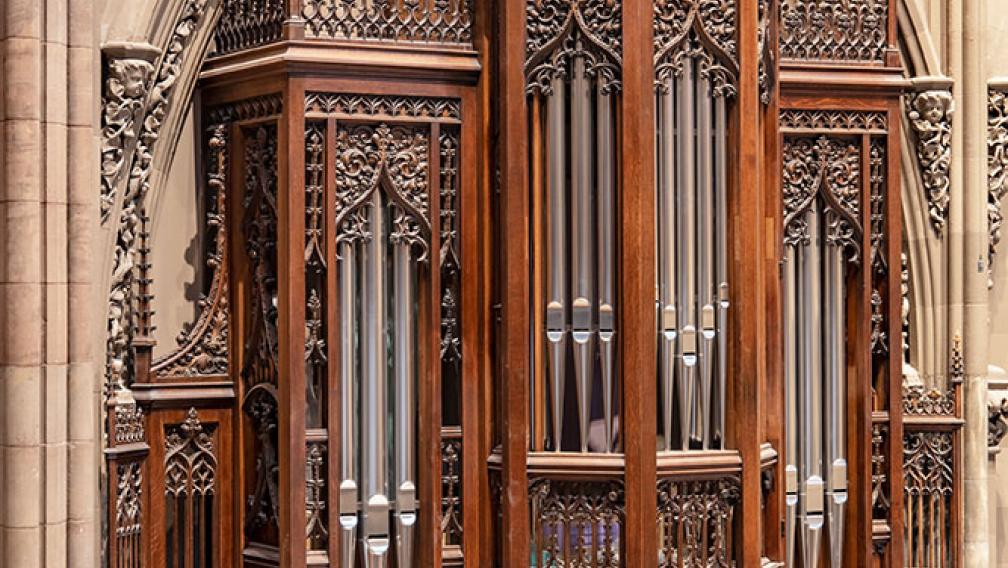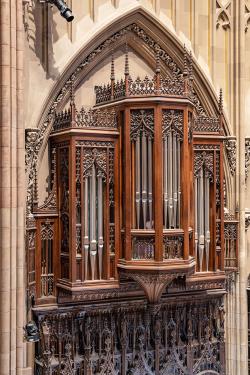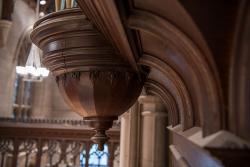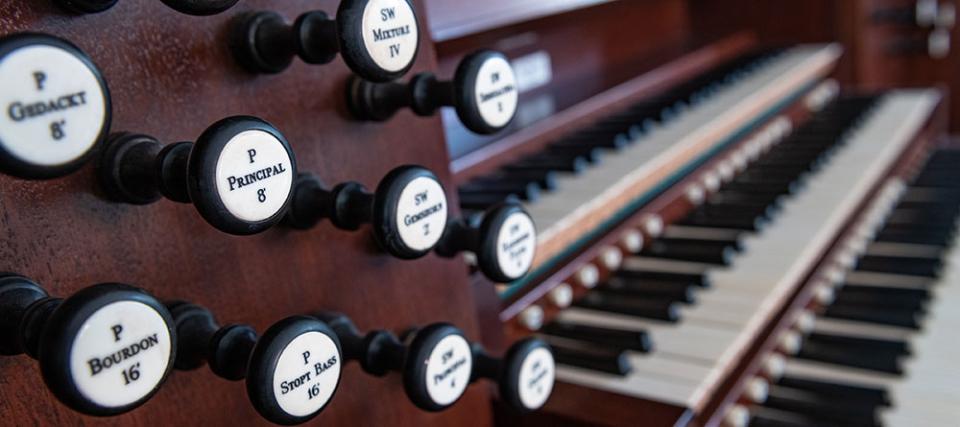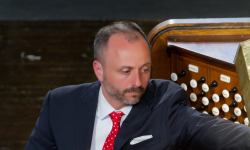Since the arrival of the first organ in 1741, many instruments have led sacred music in the historic spaces of Trinity Church Wall Street. In 2017, a reconstructed organ built by the Noack Organ Company was installed at St. Paul’s Chapel. This instrument plays a vital role both in worship and in concert.
Now, two new pipe organs are being built for Trinity Church. The nave will house an organ constructed by Glatter-Götz Orgelbau with Manuel Rosales as tonal designer, to be completed in 2023. Trinity Church’s Chapel of All Saints will receive a new instrument by Richards, Fowkes & Co in 2022.
Ever wonder where these organs come from or how they work? Read on!
Trinity Church, designed by Richard Upjohn in 1846, has a storied history of pipe organs, from the great 1846 Henry Erben, designed by Edward Hodges, to its various changes by Roosevelt, Odell, and Hook-Hastings. A chancel organ by Hall & Labaugh was added in 1864 to support a choir of men and boys, which was introduced that year. When the chancel was renovated in 1901, a new instrument from Hook-Hastings replaced the Hall & Labaugh.
All of Trinity’s twentieth-century pipe organs came from the houses of Skinner and Aeolian-Skinner. The 1923 organ, Opus 408, was the first time all organ forces were controlled by electric action from a single chancel console. Iterations of this instrument, and its Aeolian-Skinner replacement in 1970, eventually resulted in twin consoles, gallery and chancel. This organ was removed in 2003, and in 2017 was re-manufactured by Casavant Frères for the United Methodist Church in Johns Creek, a suburb of Atlanta. Musical leadership from 2003 until 2017 was provided by an experimental digital instrument, Opus 1, from Marshall & Ogletree of Needham, Massachusetts, and comprised of twin audio setups, chancel and nave, with consoles in both locations.
In 2015, Glatter-Götz Orgelbau of Pfullendorf, Germany, with Manuel Rosales as tonal designer, were engaged to envision a new instrument for Trinity Church. The new organ is conceived along the lines of its predecessors, a united instrument of 113 independent stops between chancel and gallery sections. The chancel has 28 stops across Great, Swell, Positiv, Solo, and Pedal. The gallery’s 85 stops are apportioned among Great, Swell, Choir, Rückpositiv, Solo, and Pedal.
The organ’s appearance will undergo subtle changes. In the chancel, the side portions of both cases have been rearranged to house pipes in traditional practice. On the south (left) side, a new four-stop Positiv will contain an eight-foot Principal in façade, with a flute chorus within. Opposite, the Great’s Diapason and Octave will live in the case, with the remainder of this department enclosed in the Swell. The doubly enclosed Solo will contain a chorus of powerful trumpets alongside ethereal voices.
In the nave, Upjohn’s majestic 1846 case survives as the church’s oldest continuous piece of furniture. Minor alterations are envisioned to the upper pipe flats, to increase visual interest, and new façade pipes will be installed. The gallery railing, which once housed the Erben organ’s Choir section, will now have a 10-stop Rückpositiv, with an intimate character on light wind pressure. Modifications to the gallery railing from 1970 will be reversed, and the new ‘Chaire’ case will be sensitively integrated. The interior departments are arranged in a traditional manner, with the Swell placed prominently, high up behind the crest point.
The stoplist will be published after installation. Notable features include a duophonic 32-foot Open Wood, together with three other 32-foot voices, and a quartet of Tubas of differing characters on varying wind pressures. In keeping with precedents set by the original instruments, all façade pipes will be gold-leafed. A mobile console will allow leadership from the chancel and front section of the nave. Both consoles will control the entire instrument. This organ will be completed in 2024.
In August 2016, Trinity selected Richards, Fowkes & Co. of Ooltewah, Tennessee, to design a new organ, their Opus 26, for the Chapel of All Saints in Trinity Church. Following a three-year design period, Trinity signed on with the builders for a 19-stop, two manual and pedal organ with an unusual design. The new instrument’s chief feature is its quarter-comma meantone tuning, which creates an essential ingredient for the sound-world of western music’s earliest keyboard repertoire.
Just after Easter of this year, the new instrument was completed in the Chapel of All Saints, with two keyboards and 27 foot pedals playing 1,148 pipes. Like most organs, the pipes themselves are formed of numerous shapes and sizes: metal pipes both cylindrical and tapered, wood pipes (some pyramidal in form), and still others with beating brass tongues in tones imitative of baroque trumpets and oboes. But unlike most organs, this instrument’s tuning system is intentionally ancient, with unequal intervals between each key. The instrument has 15 pipes per octave, with separate pipes for D#/Eb, G#/Ab, and A#/Bb.
Most organs using this tuning system employ double-sharp keys, one piggybacking on the other, to permit access to each sub-semitone. In Opus 26, these pipes are selected by three mechanical levers, one for each pair of accidentals. As a result, some key signatures sound uncommonly pure, and others richly dissonant, following tuning systems used before the 19th century and particularly suited to Renaissance and early Baroque music.
Housed in the same alcove as its 1912 Hook-Hastings and 1984 Bozeman predecessors, the organ retains the 1912 enclosure designed by the chapel’s architect Thomas Nash, which has been renewed, extended, and fitted with new pipes gilded in 23.5-carat gold leaf. To each side, new screens of wood and wrought iron conceal the larger pipes at the organ’s left side. The key desk is directly below the organ behind the parclose screen, where every connection from key, pedal, and knob to mechanism and pipe, is entirely mechanical, giving the most direct connection possibly between the fingers and the sound.
The Noack Organ Company’s Opus 161, installed in St. Paul’s Chapel in 2017, is a reconstruction of an earlier Noack, Opus 111, installed in 1989 at Church of the Redeemer in Chestnut Hill, Massachusetts. As Redeemer was in the process of selling the Noack and acquiring a new organ in 2015, the music team at Trinity, including myself, set in motion the process of bringing this instrument to New York because we were convinced of the Noack’s suitability for St. Paul’s Chapel.
In September 2015, Trinity Church commissioned Noack to undertake a study to explore how the Opus 111 could be re-engineered into the historic, although altered, organ case at St. Paul’s, installed by English organ-builder George Pike England in 1802. This case had been altered three times: first in 1870 by Odell, who added side wings and a crowning, exposed swell box; again in 1928 by Skinner, who provided a different swell box; and finally in 1964 by Schlicker, who removed the swell box and furnished new façade pipes. Noack’s president, Didier Grassin, deftly showed how subtle alterations could restore good proportions to the case, while permitting all of Opus 111’s 29 stops to be fitted comfortably inside.
The revitalized organ arrived in New York in September 2017 and was ready for use that November. Its official debut in February 2018 included a full week of recitals, choral offerings, and concerts with NOVUS NY, Trinity Baroque Orchestra, The Choir of Trinity Wall Street, and guest organists and soloists. Today, the instrument leads worship at St. Paul’s Chapel and is featured in weekly Pipes at One recitals, welcoming guest organists from around the world. Learn more about the Opus 161 organ’s specifications.
Continuo Organs
Trinity owns two portable organs from Klop Early Keyboard Instruments of Garderen, The Netherlands. These versatile instruments are ideal for accompanying early music, from Renaissance motets in Sunday morning services to Bach cantatas on our Bach at One series.
About the Author
Jonathan Ambrosino is a Boston-based organ technician, project adviser, writer, and tonal finisher for pipe organs. He has been working with Trinity’s music team since 2015.
